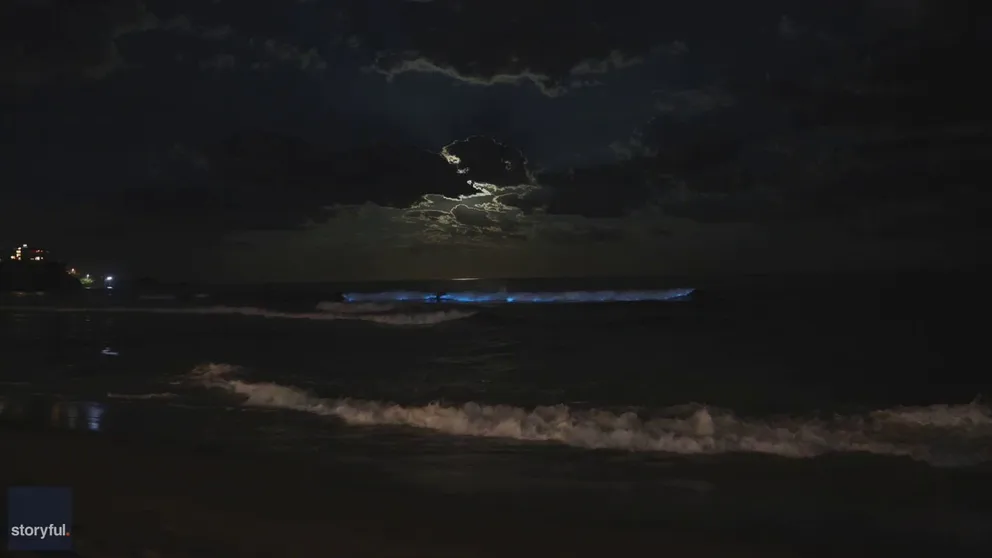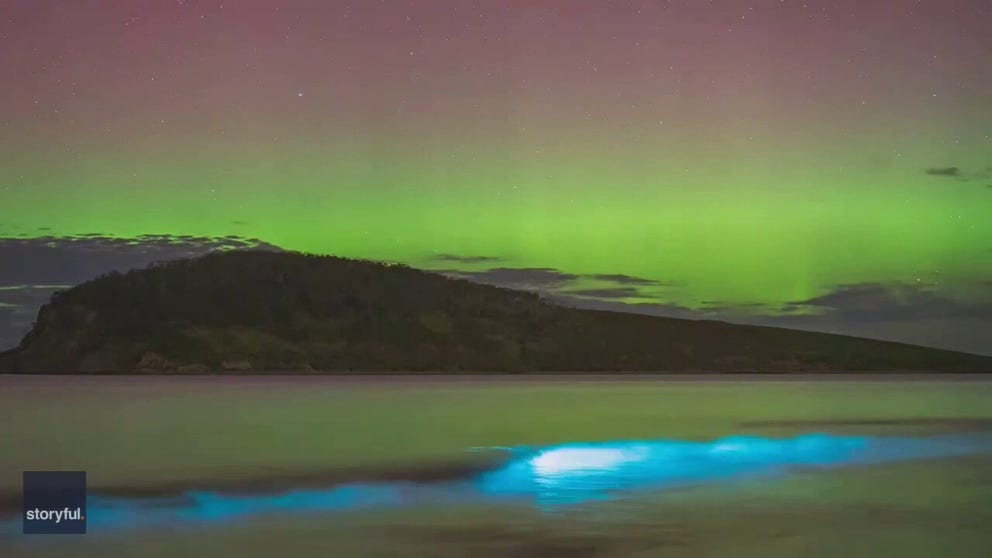Watch: Glowing wave crashes on beach in Australia
Algae blooms glow when disturbed at night creating the natural light show in oceans around the world. Other animals glow too.
Caught on video: Neon wave crashes in Australia
A late night beachcomber in Sydney, Australia was treated to a show. A neon blue wave crashed under the spooky late December moon. The glow is bioluminescence.
MANLY BEACH, Australia – A night beachcomber in Sydney caught a late Christmas gift from Mother Nature on camera, a neon blue wave, glowing with bioluminescence.
The sight, more befitting of glitzy Las Vegas, is all natural, a chemical process. Some living organisms, like algae, emit light when disturbed by the surf. Scientists say the glow is a common sight in South Australia, especially when the sea is calm and warm.
GLOWING REVIEW: EXPLORING THE BEAUTY OF BIOLUMINESCENCE
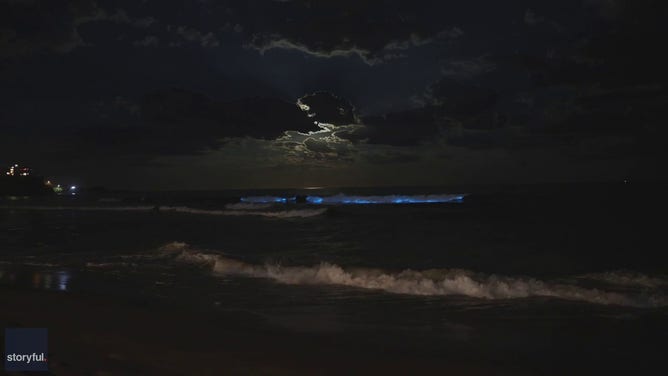
An electric blue wave lights up a Sydney beach.
(Anthony Haber Photography via Storyful / FOX Weather)
Why does water glow?
"Marine creatures like some fish, squid, tiny crustaceans and algae produce bioluminescence to either confuse predators, attract prey or even lure potential mates," wrote the South Australia Department for Environment and Water.
Humans usually see the sparkle on a crashing wave when there is an algae bloom of plankton, lots of bioluminescence in the water.
You don't have to travel halfway around the world to see glowing waves and water though. The U.S. has its share of bioluminescent sparks. A red tide created widespread light shows in the waters off Southern California in 2020.
PHOTOGRAPHER CAPTURES BIOLUMINESCENT GLOW IN WAKE OF SEATTLE FERRY
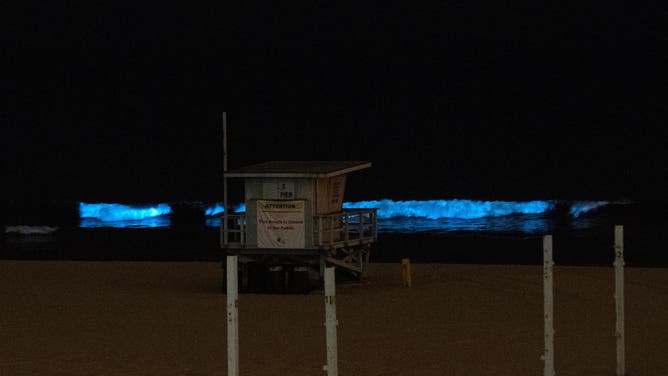
File: A lifeguard tower is seen as bioluminescent waves crash on the sand, shining with a blue glow on April 28, 2020, in Manhattan Beach, California.
(VALERIE MACON/AFP / Getty Images)
"Each microscopic cell contains some ‘sunscreen,’ giving it a reddish-brown color," said Michael Latz of the Scripps Institute of Oceanography in an article. "On sunny days, the organisms swim toward the surface where they concentrate, resulting in the intensified coloration of the water — and the reason for the term ‘red tide.’ At night, when the phytoplankton are agitated by waves or other movement in the water, they emit a dazzling neon blue glow."
Most of us think of massive fish kills and beach closures when it comes to red tide. But it turns out the harmful algal bloom has a sparkly side too.
THOUSANDS OF DEAD FISH ALONG THE TEXAS GULF COAST; RED TIDE ALGAE CONFIRMED TO BE THE CAUSE
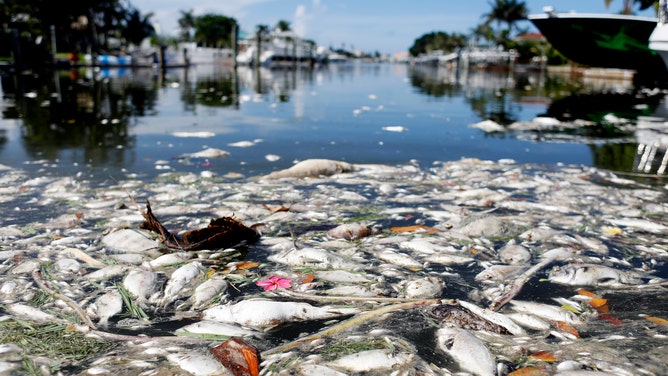
File: MADEIRA BEACH, FL -: Thousands of dead fish float in the Boca Ciega Bay located near the mouth of Madeira Beach on July 21, 2021 in Madeira Beach, Florida. Red tide, which is formed by a type of bacteria, killed several tons of marine life in Florida.
(Octavio Jones / Getty Images)
The blooms can last from days to months. Not all red tides are bioluminescent though.
What else glows?
According to Latz species of jellyfish, clams, squid, shrimp, sea cucumbers, fungus, sharks and fish can glow. In the deep ocean, void of sunlight, more than 90% of animals are bioluminescent.
‘TRUE FORM OF MAGIC’: GLOWING FUNGUS MAKES FOR SURREAL NEON SCENE ALONG DARK WASHINGTON BEACHES
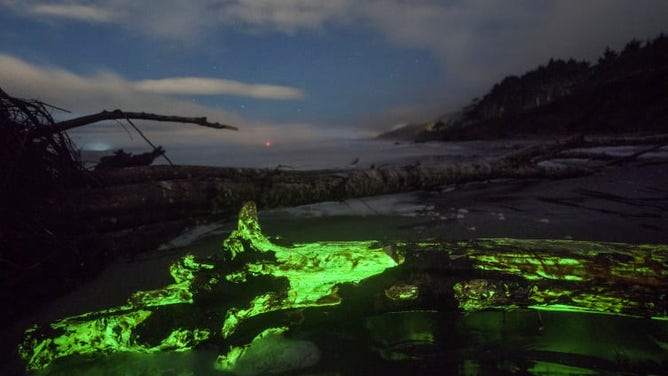
A fungus glows green on a dead tree along Washington's Kalaloch Beach on Nov. 19, 2021.
(Matt Nichols Photography / FOX Weather)
You don't even need to head to the coast to see bioluminescence. Fireflies glow thanks to the same chemical reaction. Fly larvae (called glowworms), a snail, some earthworms, some mushrooms and some centipedes light the night as well.
Colors range from blue to red, depending on the animal's chemistry.
FIREFLIES FIND ROMANCE BY GLOWING IN THE DARK
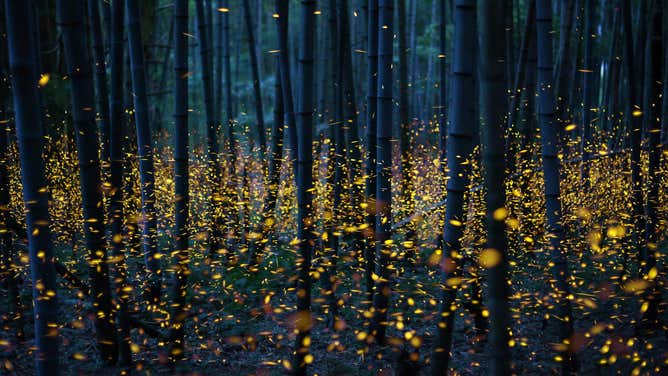
File: Fireflies light up a forest.
(Kei Nomiyama / Future Publishing / Getty Images)
The light emitted from energy released by the chemical reaction differs greatly from the light from the Sun or a light bulb. Energy from the sun and bulbs comes from heat, said Latz.
Any cells can glow
The Latz lab at Scripps found that all cells can glow. Scientists can actually artificially induce bioluminescence.
‘ABSOLUTELY MIND-BOGGLING!’ AURORA CHASER SNAPS GLOWING SKIES, GLOWING JELLYFISH IN SAME PHOTO
Watch: Time lapse video shows vibrant aurora dancing above bioluminescent water in Australia
A photographer captured time-lapse video of a dazzling aurora lighting up the sky above bioluminescent waves in the Greater Hobart area, Tasmania, on February 16.
"All cells have the ability to produce ultra-low levels of light due to oxidation of organic molecules such as proteins, nucleic acids, etc," states the Latz Lab website. "Through a very long process of natural selection, the organisms we call bioluminescent have developed the ability to enhance light production through physiological, molecular, anatomical, and behavioral adaptations."
